We’re back in Kathmandu after a rollercoaster week. I’m staying at the Hyatt Regency, probably the nicest hotel in KTM and a bargain at $125pn, sitting by the pool on a recliner having just eaten way too many pancakes with cream and syrup. Yesterday Jon and I played golf at the only local 18-hole course in Kathmandu. We had golf carts and caddies, and they delivered beers and club sandwiches to us out on the course. I won 6&4. We’re enjoying a bit of luxury before we head home as we decompress from our two-month trip to the high Himalaya.
To recap: we’d aborted an earlier attempt at the summit following a delay in rope fixing, which led to a number of climbers heading home early. We’d then missed a second potential weather window on May 16th, as we had just arrived in Namche and it looked risky based on the information we were given at the time. We then agreed to let the main crowds target May 20th to 22nd, also believing that the weather and crowd combination was not optimal. Several climbers lost their lives during that period. We were then skirting perilously close to the end of the season, as the Icefall doctors typically close the route through the Khumbu icefall on June 1st.
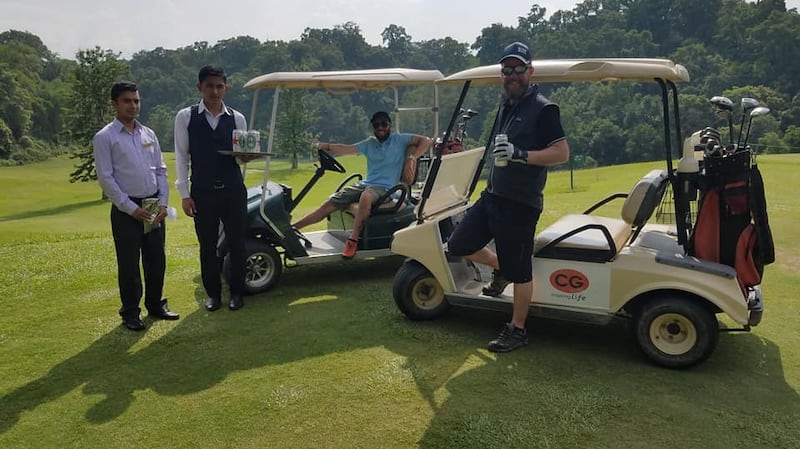
Everest meteorologists had for some time been calling this the toughest forecasting season in living memory. The only thing they seemed to agree on was the difficulty predicting movements in the jet stream and the overall volatility of wind patterns. As we sat in our base camp mess tent debating the optimal window for our last chance summit attempt, we were now relying on a forecast five to six days out for May 26th. This made me nervous.
After the May 21st to 22nd window, the jet stream was expected to return to buffet the summit over May 23rd to 25th. For the 26th, the winds were meant to start the day a little brisk, at 25 miles an hour, but then fall steadily from around 4am. Our approach was going to be to start later than the usual 8-10pm time and take advantage of the predicted lower winds from 4am onwards. We also believed we’d be able to move fast, as we’d have the mountain more or less to ourselves.
Given the way our expedition was set up, we didn’t have access to full updated forecasts once we were on the hill. This wasn’t ideal but we were able to listen in to radio calls between larger expedition base camps and their teams higher up. We’d hear their views and what they were recommending for their clients.
Our German team member “Rocket” Ronny was Lhotse-bound and, given the lower elevation, summit winds and smaller crowds, he decided to go for his summit on May 21st. As we continued to delay our departure we followed his progress. When he arrived in Lhotse high camp with Pemba Sherpa, they realised their oxygen supply had been compromised. Someone had been into the tent, stolen the fresh bottles and left some empties. Such actions could kill in the wrong circumstances and the perpetrators could find themselves up on manslaughter charges. I guess people don’t care in the heat of the moment. Luckily we had an extra stash nearby and Pemba was able to resupply.
From Lhotse high camp Ronny summited in around six hours. At the top, he had great clear views and nearly stumbled onto the exposed body of a climber from a previous year. Going up he felt fine but coming down he ran out of oxygen and subsequently energy, though he cracked a rib, and even ended up “dexing” himself with help of the medical kit he had on him. Dexamethasone is a powerful steroid best used to reduce swelling associated with cerebral oedema and is not the right treatment for exhaustion. With no working comms and his Sherpa already descended, he did what he thought was needed. The placebo effect was enough for him to pull himself off the mountain in his own way. With Cian Brolchain the first Irishman ever to summit Lhotse days earlier, the Rocket brought up the second tricolour within a week, to honour his good friend and long-time supporter Chanel from Clare.
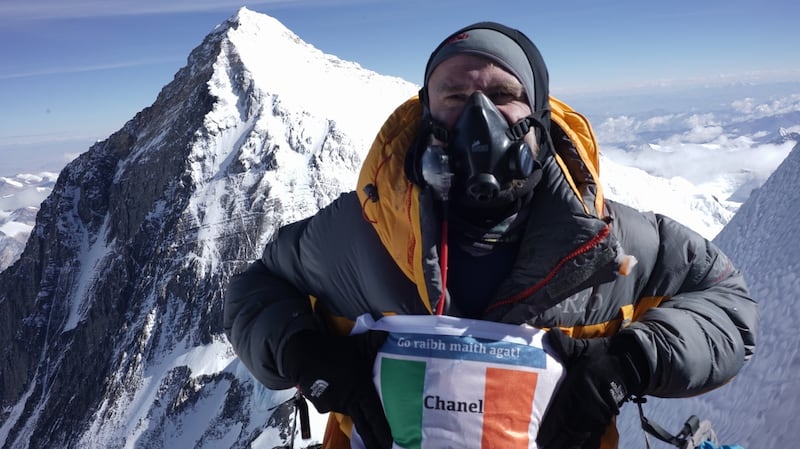
Finally, on Monday May 22nd we decided to make our move and get positioned at Camp II. The icefall had become more ominous. This would be our seventh transition through the icefall. As we moved through May we could see the effects of the ongoing melt on the lower sections, which heightened our concerns around its overall stability. Jonathan, Blake, and I moved as a team through this section and eventually made Camp II in around seven hours. This was a worse time then previously.
We were all a little concerned that six days eating doughnuts in Namche followed by four days on our arses at base camp had been too long. Perhaps we had lost some fitness and/or acclimatisation. The following day we rested up, knowing that this would be our last chance to do so. We’d also had our oxygen supply at South Col checked, following the events at Lhotse high camp. Just as well because eight bottles had been pilfered. Pretty annoying given the relatively small number of people on the mountain and the risks of leaving someone short of oxygen. We’d need to resupply our high camp as well, and this meant extra work for our Sherpa team.
At 4am on Wednesday May 24th we proceeded from Camp II up the Lhotse face to Camp III. This was the third time in a month we left for Camp III but the first time we’d make it all the way. Previously we’d been pushed back in high winds during our acclimatisation rotation and then aborted our summit attempt as we heard the ropefixing had been abandoned mid-way through the day.
The Lhotse face is a 1100m wall of glacial blue ice rising at 35-50 degree pitches with occasional steeper sections. An unclipped misstep almost anywhere on its surface would lead to a long, accelerating, unstoppable slide all the way down to the bergschrund (the name given to a crevasse at the junction of a glacier with a steep upper slope). Even ensuring you are always clipped into an anchored rope with at least one carabiner, it’s a tough slog.
As we moved up the Lhotse face on the left line, a group of six Sherpa were taking down a body in a sled. The body was wrapped up tight in the sled but with some human features still showing and mountain boots sticking out. The Sherpa tried lowering the body slowly, using the fixed ropes for support. As they passed us, two of the recovery team slipped and slid down the line, crashing into the body and desperately trying to use it as their means to stop. Even then, they accelerated a further 50 metres to the next anchor. It was a timely reminder, as we moved up on our final push, that this mountain takes lives at will. Even in good conditions down at 7000m, it was complicated for six qualified mountaineers to move a body. With that in mind, you can’t expect a rescue if you become incapacitated higher up the death zone in a storm.
We arrived at Camp III at 11am. I was sharing with Jonathan and we got to it – boiling up snow and ice, rehydrating and eating. Losing energy would be one of the easiest ways to fail on summit day and maintaining minimum levels on these prior days was a key part of our route to success. We were on the lower end of Camp III at 7100m and the ropes stretch right through the camp. Any exit from the tent, whether to gather snow for boiling or to answer nature’s call, required the utmost care as any slip could be fatal.
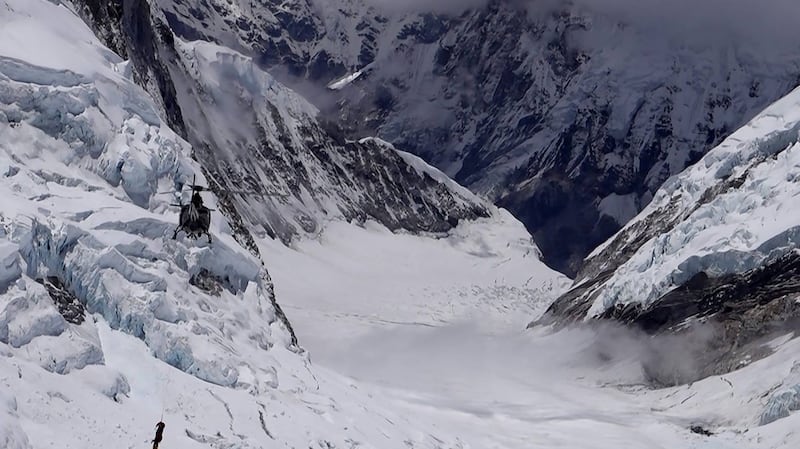
That afternoon I heard the whirr of a helicopter and looked out the door of the tent to see a “long line extraction” happening only 30 metres away. It’s impossible to land on the angled hard ice of the Lhotse face, so they attach 20 metre-long rope with a carabiner at the end of it to the undercarriage of the helicopter and attach to the recuee.
A groaning body was lifted up and moved down the mountain. At these moments you swallow and feel the adrenaline increase. I said under my breath, “No mistakes here, Rory, no mistakes”.
That night we broke out the oxygen for the first time this attempt and slept on a very light flow of 0.5ltrs per minute, primarily to try and avoid frequent waking due altitude-induced sleep apnoea. It worked. I had one of my better night’s sleep of the trip and this gave me strength and confidence.
I was excited on the morning of the 25th. Finally we were moving up to the South Col and we’d be moving on oxygen for the first time. We’d also be travelling through exciting landmarks from Everest history – up the final part of the the Lhotse face’s steep icy slopes, across a rock feature called the Yellow Band, and up the lateral ridge of the Geneva Spur which takes you up to the South Col where Camp IV is situated.
Moving on oxygen certainly made the first part of the day quite easy compared to the day before. Jonathan tore ahead and I progressed with Blake. We stopped occasionally to check each other’s oxygen pressure gauges and take the odd break for a chat.
Blake had stopped at one of the anchors and when I reached him, he pointed up at another body moving down the hill with an extraction team of six. We were on the same rope so it would be much easier, safer, and faster for everyone if we could hold up at this anchor and allow them to pass. This time you could tell this was an extraction of someone who had been on the hill for quite some time. The visible hand was a strange shade of brown and all the fingers were missing. You didn’t want to look but equally couldn’t entirely help it as you pass in close quarters.
We enjoyed moving across the Yellow Band and stopped to chat with one of the Himex guides while approaching the Geneva Spur. He was sitting on a mound in the sunshine waiting for his clients who were still some way down the slope.
When we got to the base of the steepest section of the Geneva Spur we decided to check each other’s oxygen supply. Initially, Blake thought my bottle was empty but then we realised that it had come undone and needed to be screwed back on. We reckoned I’d been without oxygen since we last checked 30 to 40 minutes earlier. I had felt my lungs working hard but had been managing okay. We’d been on 2ltrs per minute but now I decided to crank it up to 4ltrs per minute to get up the steep section. Boy, it felt like we could run up those slopes! From that point we made the South Col in no time at all (noting that if there was a video of this “fast” movement, it would no doubt still look painfully slow).
At our tent at South Col, we would have around ten hours before leaving for the summit. This was time for food and drink, a snooze and then waking up, boiling up and eating and drinking again and then preparing to leave for the summit. Our summit team would be myself, Jonathan, Blake, Jabbu, Gyalgjen Dorjee, and Dorjee. Each of us would be moving up with a hugely experienced climbing Sherpa. Dorjee, 32, would be at my side all the way to the summit and back, this would be his 14th summit and, in case it’s not obvious, these are the true athletes and heroes of this mountain.
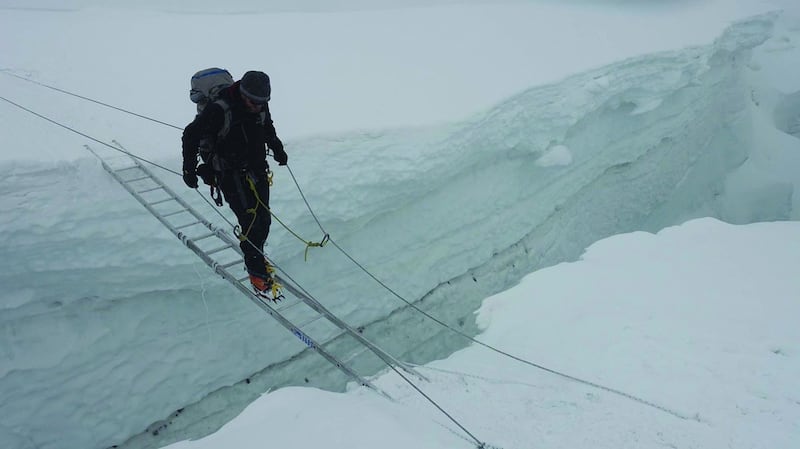
Dorjee is an absolute legend and it was great to know he’d be next to me for the most dangerous section. Our guide Tim had chosen to complete his own personal summit earlier in the season without clients and therefore stayed in high camp, as double summits would require an extra permit which he chose not to purchase.
The alarm woke us at 11.30pm. I hadn’t fallen asleep until 10.30pm but was still relieved that I’d had some sleep. It gave me a positive feeling. Getting on the downsuit, boiling up again, harnesses, crampons, a new bottle of oxygen fixed up – I was ready to go. It was 2am when we set off.
Starting in darkness, we headed off with head-torches on. A light incline snow and ice slope gave way to an increasingly steep slope. We were roped in. The beauty of starting in the dark is that for the first few hours there are no distractions and the enormity and steepness of the slopes ahead are not yet visible, you can get yourself into a routine and just motor on. At around 5am, when the glow on the horizon appeared and the need for the headtorch slowly reduced, we could see the long slope ahead leading up to the Balcony, a rocky outcrop and the place where usually we change our first oxygen bottle. The weather looked uncertain, lower down the mountain looked good, but higher up it was hazy as daylight beckoned.
As far as we were aware there was only one other group on the mountain – three clients from Himex (one of the more exclusive operators offering trips for $75000 nearly double the cost of ours) with their support team of guides and Sherpa. They had left over an hour before us. With so few others on the mountain there wouldn’t be any queues so we could afford to be more aggressive with our three bottles of oxygen. We started with oxygen pumping at a healthy 3ltrs per minute. We made strong progress straight out of the camp. One step in front of another, pushing up the jumar on the rope to provide extra support. At each anchor we were going through the now familiar routine of unclipping and reclipping your carabiners into the rope. Making sure always to be safely attached. A slip on any of these surfaces without the rope could easily lead to a fall of over 1000m.
I managed to start with warm feet for a change, having had my feet strapped into my inner boots and inside my -40C-rated expedition sleeping bag until the last possible minute. An hour in, they started to feel cold and I ensured with every step that I wiggled my toes. That way I kept the blood flowing and could aim to keep them from freezing until the day warmed up when the sun came in a few hours.
Moving on up to towards the Balcony is an area called the Chimney, where you have to shimmy up through a small rock funnel. The rope was snagging on the rocks here and the outer sheath had been completely ripped through for a section of nearly 10 metres. The rope continued to snag as it was pulled left and right. You needed to keep an eye out on these sections and try to put less of your body weight on the rope. After all, it could break and if you had all your body weight on it, you’d slide right off the face of the mountain.
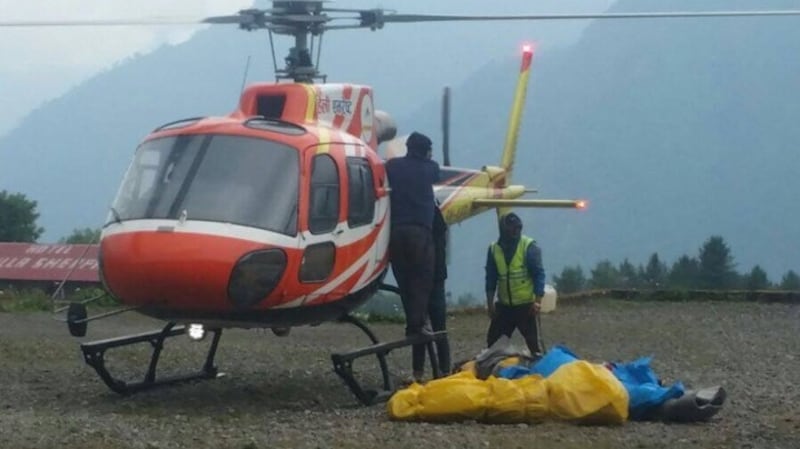
We moved slowly up a very steep section and then pulled ourselves over the edge. In doing so I noticed, out of the corner of my eye, a climber lying just off to the right. Wait, he isn’t clipped, why is he . . . oh shit, this is one of the new dead bodies on the route. Wearing a red downsuit and tied into position with rope, an anchor, and some oxygen bottles, the body of this poor climber was a startling reminder, again, to keep our wits about us and move efficiently and safely towards the summit.
Mistakes and poor fortune can take your life in the blink of an eye on this hill. It’s amazing the way these moments sharpen the mind – a shot of adrenaline, an immediately improved posture, a slightly quicker step, improved hand eye coordination and work with the big gloves and carabiners in clipping in and out. It starts to wear off quickly but you need to try and maintain focus with the odd swig of water, some sugary sweets, anything you can do to keep your mind concentrated.
It continued to get brighter but we only got hit by direct sunlight and felt its warming effect when we emerged on the Balcony. The cold feet from earlier were cured. Jonathan arrived at the Balcony around 20 minutes before me. Jonathan was moving up the mountain with 10-time summiteer Jabbu. They chose to make the standard change of oxygen at this stage. Jonathan recounted having his oxygen removed for over five minutes during this process, which left him feeling giddy and incapable of even the easiest tasks. Perhaps not observing the best protocol, Jabbu first removed Jonathan’s oxygen supply before asking him to find a new bottle in his backpack. “It’s incredible when you realise how much the oxygen is making a difference, only 5 minutes disconnected on the Balcony and I could barely function and felt like a drunken two-year-old. It makes you feel vulnerable up there”, Jonathan said afterwards.
We eventually reached the Balcony. Blake was just behind me all of this way. We were at very similar pace going up over the past few days and it was reassuring to be in a slightly larger group of four rather than just Dorjee and myself. Dorjee checked my oxygen and, given we had an ample supply, we continued moving to a secondary place further up the line. This would give us extra supply and enable us to move on a higher flow later in the day, all being well. More oxygen gives more options and an extra safety net.
From the Balcony it was a long slog up the south summit – up steep snow slopes, rocky areas, and a ridge. For me the next exciting landmark was the Hillary Step, reportedly no longer there in its original format following the 2015 quake, which had dislodged the bigger rocks. There in its original form or not, the obstacle remains a careful one to negotiate. At different times you’d be pulling yourself up a steep ice and snow slope or negotiating your way across smooth-angled rock slabs, which were tough to get secure footing or “purchase” on with our crampons. It was at this point where I passed the Himex team coming down and witnessed three of them take significant slides and stumbles. I determined to safely attach my figure-8 and rappel this section on my return from the summit.
Above the Hilary Step (or perhaps more aptly the Hilary Rubble) we emerged onto the summit ridge. The summit itself was still obscured by the angles of the ridge, but I’d read enough books and seen enough photos to know I was close. I wasn’t going to fail to make it from here. I passed Jon who had just left the summit and we high fived and gave each other a hug. As I emerged over the final ridge line, which gave sight to the summit and grouping of prayer flags, my eyes welled up a little. This was the culmination of two months in the Himalaya and of nearly six months of prep and training. It felt great.
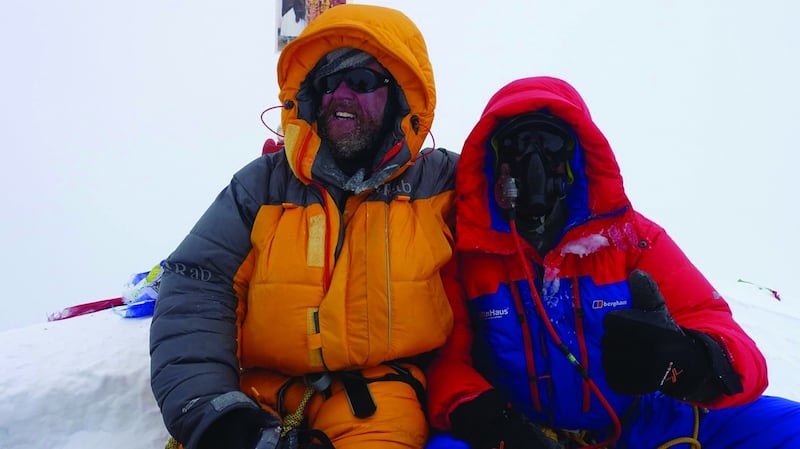
Arriving at the summit, I found the weather had closed in completely since Jon was there. The winds were intensifying every minute. Dorjee and I took photos and made a few videos. Blake and Gyalgen Dorjee were only a few minutes behind and soon joined us. I completed what I believe might be the highest ever frisbee throw, although regrettably incomplete as an almighty gust of wind took the frisbee off into Tibet. I’d like to take this opportunity to apologise to the Chinese government, it was not my intention and if possible I’d like my frisbee back. After all if would have been illegal to have crossed into China after it!
I sent a message on Facebook and Twitter from my satellite communicator that we were on the summit. We hugged, high fived, and laughed but at the same time we were acutely aware the job was at best half done. We were high in the death zone and in the middle of an incoming storm not in our forecasts. We’d all read enough about Everest disasters so after 20 minutes at the top we decided to get a move on and heading down.
As we descended, Blake and Gyalgen Dorjee took up a position around 25 to 50 metres behind Dorjee and myself. The conditions were bad and clearly deteriorating, we now just wanted to be down at Base Camp, safe and sound.
Blake turned around, he was on his own. Visibility was down to 10 metres. He moved back 20 metres, he looked left and right, he shouted. Five minutes went by. His climbing support Gyalgen Dorjee had vanished in the death zone. He quickly moved down the line hoping to catch us up and shouting for us to stop. As the last man on the hill that day this was a traumatic experience and Blake would later confide “I assumed Gyalgen was dead and you guys had left. I thought I would run out of oxygen and die up there. All I could think of was my family and trying not to be the second dead body on the route.”
We were just approaching the Balcony when he reached us. The winds were at their most ferocious. It was impossible to keep my eyewear from fogging up, given the accumulation of water in the oxygen mask, volume and intensity of blizzard and spin drift peppering our faces from all angles. I’d clean the goggles, have one minute of reasonable visibility, another two to three minutes of being able to make out general shapes and people, and then I’d be back in the fog with no visibility, feeling my way down and using the ropes for navigation.
Dorjee was clearly concerned for Gyalgjen Dorjee. He’d now been missing for 15 minutes and had completely left his client, something was wrong. So, when he appeared from the mist, we were all relieved. He had fallen down a snow slope, only stopped from falling right off the mountain by the rope to which he was attached. Shaken but not injured, he had managed to climb back out but it had taken him some time. If he had injured himself badly in the fall, that most likely would have been it. In the meantime the storm had been intensifying. We moved slowly down the face. Clipping in, walking as carefully as possible.
As Jonathan continued to move down ahead of us, he decided to rappel down sections which would usually be walked. The whiteout, winds, and spin drift combined to make it very difficult to consistently stay on your feet. An hour from reaching the South Col, Jon was alarmed to see some fresh debris on the snow – a “summit oxygen” mask and a Grivel G12 crampon. All three of us were wearing G12 crampons and masks of the same brand. He was convinced until we met later that one of us had taken a major spill and feared for the worst.
Blake and I fell many times on the way down. Once back at South Col, I crawled into the tent between Blake and Jonathan and lay my head down on an oxygen bottle. I couldn’t have found a less comfortable pillow but I was too tired to deal with it. We had an hour to boil water and fill water bottles, eat something, and rest before leaving to move down the mountain. Typically, moving down to Camp II is the preferred course of action but staying at South Col is an option. The storm on the way down had wrecked us, particularly Blake and me. We argued for staying as we were concerned about our ability to safely descend. Our expedition’s plan, however, was to immediately dismantle the camp to avoid a further trip up. So, despite our protests, and an hour later than originally intended, at 4pm we headed out of camp down the Geneva Spur and across the Yellow Band to the Lhotse face.
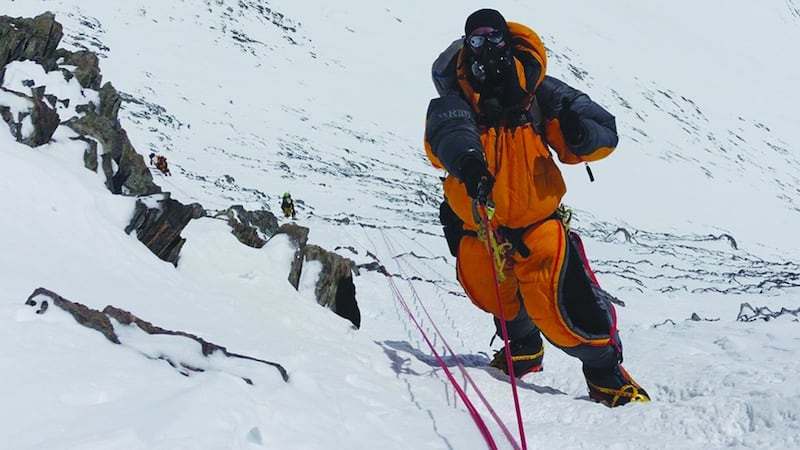
We hit the Lhotse face in dusk and put our headtorches on. We passed Camp III. It was completely calm, not a breeze, not a sound other than that of my own breathing through my oxygen mask. The dark continued to descend, with a low moon it was going to be dark tonight. Ahead in the distance we could make out a number of figures sitting down on the snow not moving. Blake and I took a break and couldn’t work out what people would be doing there as dark fell, it was slightly unsettling, and never likely to be positive but we continued to move down. Why weren’t they wearing head torches, why weren’t they moving? Finally as we neared the group, we could make a out sled - another body recovery operation. To pass them, we had to clip around the recovery workers and then clip around the sled. If I never have to pass another body at such close quarters again, I will be happy.
Shortly after this we reached the bottom of the Lhotse face. Our final significant obstacle of the day was the bergschrund. We’d need to rappel down. We were completely exhausted. There were two similar red ropes attached to the anchor. I pulled both up about 10-15 feet and they looked identical. We couldn’t see over the steep edge and hadn’t been here before. As both ropes were new and appeared the same, we determined that we could use either. Blake decided to go first. After a couple of minutes I couldn’t hear from Blake as I shouted down. I felt the ropes and there was no weight on either so I thought I must just not have been able to hear him on the other side of the ice wall. Not unusual, I thought to myself as I clipped on my figure-8 and prepare to abseil.
I pushed myself over the edge and started to descend. Looking down I could see Blake, and he shouted, “You’re on the wrong rope!”. Sure enough, looking down my rope stopped abruptly close to the bottom but not close enough. Luckily, I was in control. I slowed down, moveed my safety carabiner to the other rope and descended really slowly through the abseil so that when I reached the end of the rope I could make a controlled landing and even if I slipped I’d be attached to the other rope for safety.
Blake was shaken, he had come down quickly, been surprised by the short rope and freefell, landing upside down and sliding face first towards the bergschrund. Amazingly a spare unlocked carabiner on his harness had snagged a safety rope and this had brought him to rest. We were both shaken up but comforted that this was the last obstacle of the day. It was just a one hour slog back to Camp II from here.
As we moved through the deathly quiet night below the bergschrund towards Camp II, we could see another figure. It’s a largely inconsequential hour long walk. The dangers of the day were behind us, we thought. The figure’s headtorch was moving left and right, lurking in the darkness. Why was this individual here? We approached slowly, still recovering from the close shave on the bergschrund. As we got closer we could see there was a large object in the man’s hand swinging left and right.
It was our Camp II chef Ganesh, there to greet us, an hour from camp, with a kettle full of juice. It was an amazing surprise and was very welcome given I’d finished my water higher up on the face. Getting into the sleeping bag that night at Camp II was an amazing feeling. We still had the dangers of the icefall to contend with one more time, but we were back at 6375m, had summited and survived the main test.
We got up the next morning, moving slowly and feeling very weak. We left at 9am instead of 7am as a result. We proceeded to move slowly through Camp I and down into the icefall. It was painfully slow process with a heavy pack and I felt particularly drained throughout, but we made it.
Initially we tried to get a chopper back to Kathmandu the very same day but fog had descended across the valley. At 4pm we heard a cargo plane had crashed in heavy fog in Lukla and we knew we wouldn’t be flying that day.
Although we had to wait around for four hours the following morning, the fog eventually lifted, the choppers started to fly. We stopped to refuel at Lukla and saw the wreckage from the day before in the cliff side. We went for a beer at the café next to the airstrip and I started chatting to an off-duty nurse. She’d been working for 20 hours straight, claimed to have used up just about every supply they had in the aftermath of the crash. They had just lost the co-pilot as well. Returning to the airstrip were three body bags out on the tarmac, these were recovered climbers from the hill. It was a sobering morning.
Now that we’ve been in Kathmandu for a few days and are ready to head home, it’s all sinking in and it’s time to return to some form of normality. We can’t just go on claiming new high altitude frisbee records for the rest of our lives (or not at the age of 40 anyway, or so my parents keep telling me!) I think it’s time to go home to my incredibly understanding girlfriend Jo and reconvene a slightly more normal life, for a while anyway. I’ll have to put the pee bottle away!
Looking at my compatriots on the hill this year, I’m delighted to report that Terry Kelleher has completed his seven summits, topping out on Everest on May 23rd. It didn’t come easy for this intrepid 56-yearr-old Dubliner, who ended up in Hospital in KTM for treatment on his frostbitten toes and ear. The 23rd was a tough day on the hill with high winds, so high that Terry was telling me about tents getting shredded at the South Col.
Elsewhere John Burke had earlier succeeded as the first man from Clare to stand on top of the world in the first wave on the 16th, in what looked like decent conditions. John’s been doing great work for Clare youth charity Elevate. Despite bravery and persevering through injury for weeks, Justin Condon eventually had to give up on his 2017 ambition when he cracked several ribs between Camp II and Camp III. I’m pleased also to report that Justin and Terry have long been discharged from hospital in KTM and are now at home with family and friends. I think I’m the last one still in Nepal. Congratulations finally to Cian Brolchain, who conquered the world’s fourth highest mountain Lhotse, the first Irishman to do so.
You can read Rory McHugh's Everest Diary, parts one to nine below.
*Rory McHugh has been climbing Everest in aid of Rory’s Nepal School Project with Child Rescue Nepal, to build schools in remote villages not yet recovered from the 2015 earthquake. He’s now around €5k short of funding a second school in Makwanpur so if you enjoyed the journey please check out virginmoneygiving.com/letsbuildschools
For the next two weeks as he finishes up the fund raising Rory has committed to matching all donations towards funding the second school. He’s also reachable on twitter @realrorymchugh and in exchange for a donation to the Nepal school project is happy to be engaged for public speaking or helping climbers achieve their dreams and prepare for expeditions
Thanks to Blake Penson for contributing most of the photos for this article as my camera sadly went missing when back in base camp.












